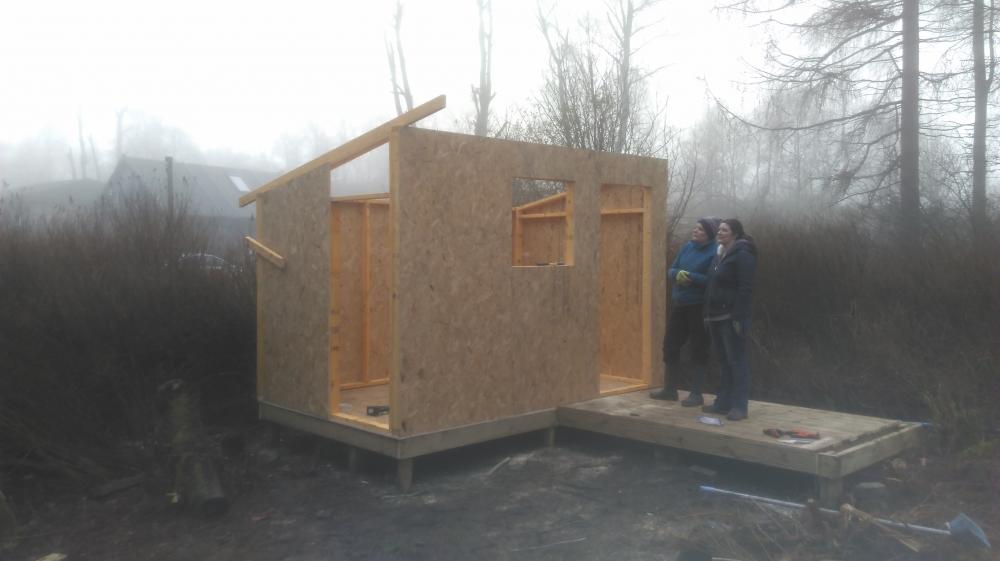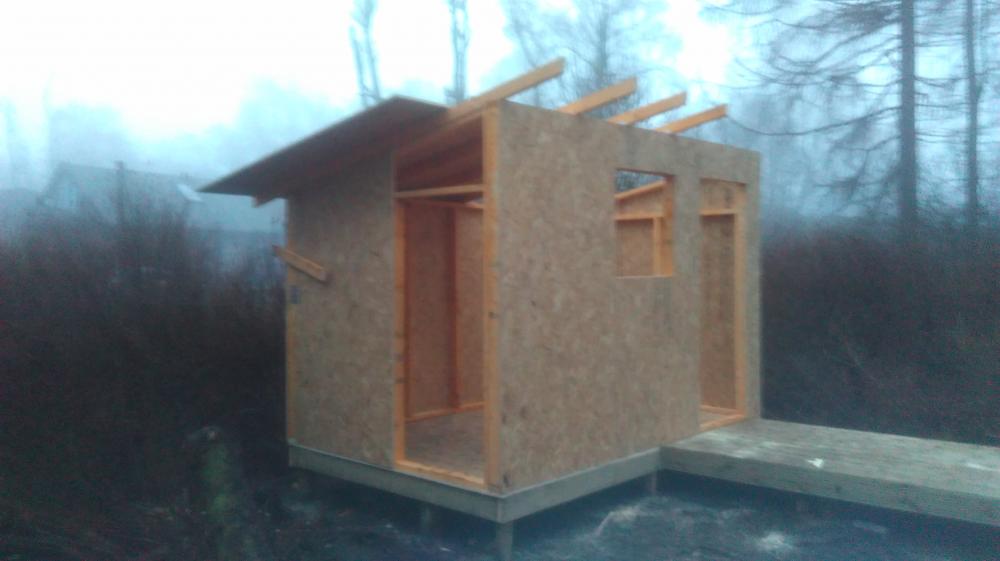Leaderboard
Popular Content
Showing content with the highest reputation on 01/21/17 in all areas
-
I had the offer of some help from a neighbour so decided to crack on with the roof sheets. These are corrugated sheets 4x1m and in the thicker 0.7mm spec, so fairly heavy and awkward things to handle. I did get the first sheet up and fixed by myself but am not daft enough to turn down an offer of help when it appears! When I bought the roofing, I had recently read @ProDave's less than glowing review of Jewsons' plastic headed roofing screws, so made a point of asking what would be supplied. The guy at the BM was adamant that everybody these days prefers the plastic headed stuff, quicker to install, no caps to come loose, just a question of getting the right bit to drive them in with. He even did a straw poll of the people in the shop at the time... Anyway, how do the screws work in real life? They certainly do not self drive, not by a long shot. And so far I have stripped the heads off two of them, although in both cases I was able to back the screw off and remove it using pliers. So it seems you need a decent hole punched in the sheet, which slows down installation somewhat. Getting the sheets up on the roof wasn't too hard once I figured out a method- I built a 'stretcher' to hold each sheet, and this is then run up a pair of wooden guide rails onto the roof. Doing the last sheet will be a bit tricky as we will have to pull the 'stretcher' out from under it, instead of moving the sheet to the side as we have been doing so far. In other news, the hole for the flue is now made- a bit daunting cutting a whopping great hole in the roof! I'll write another blog post about that as part of the stove installation,2 points
-
Well, we finally started real work. Fortunately the snow melted yesterday, but the sun shone on us today and it was perfect weather for setting out and stripping the site. We finally found a good builder with a lovely attitude and a fair price. I know these folks by reputation so was pleased to find their quote was competitive. Just the owner was on site today along with a digger driver from a firm he uses, and what an enjoyable day it has been. The two of them taking the mickey out of each other most of the day, but very,very competent guys. The archaeologist we have had to employ for the day as part of the planning conditions was just as nice and fortunately we found nothing more than a few shards of medieval pottery - which as he says, in a medieval village is to be expected. But an interesting guy to talk to as well, so I was very relieved we didn't come across anything that would have stopped the work (though I'd have settled for a golden coin hoard of course) . So all in all, a really satisfying day. Tomorrow comes trenches and hopefully the start of foundations, and I meet the BR guy for the first time.1 point
-
That's great progress in a week. I was past on Wednesday and saw the 'Readymix' wagon on site. It is always a good feeling to actually make a start after all the months of planning and preparation. Hope all goes well for the future stages.1 point
-
1 point
-
Just put some tape or sealant all around where the hanger exits the wall.1 point
-
Not hard work just time consuming. A good two days cutting and taping. You don't have to do it and just accept the heat loss, your call. Just use any insulation you have lying about. Can be sheet insulation or even cavity wall boards.1 point
-
Over time the joists flex as they shrink and expand so the cement will crack. You could put tape all the way round each gap or even cut some pir insulation and stick it to the blocks and then tape the edges. You will have to tape from you floor above to the wall and then plaster over this to seal it in. The window tape on that link can do this. It will take a fair bit of time to do it right but would be well worth it. Are you filling the joists with rockwool???1 point
-
1 point
-
I suffer from increasingly worsening tinnitus, silence is the worse thing there is. Not that a modern ASHP that is designed, installed and maintained is noisy at all. I am tempted to go and measure the noise levels from a few to see what it is at 1 and 10 metres distance.1 point
-
Well, the Statutory Instrument is the Law for PD, and it doesn't include the word "installation". The guidance on the portal however, by mis-quoting, doesn't help arguing this with the LPA. I'd definitely refer to this document (page 100 class G): http://www.legislation.gov.uk/uksi/2015/596/pdfs/uksi_20150596_en.pdf when contacting the LPA.1 point
-
Where did you get this quote from? The word "installation" doesn't appear in the English GPDO (2015), and from a quick scan of the above, nor in the Scottish version. The English version states: I therefore change my view. The ASHP just needs to be on the MCS list, the installation doesn't actually need to be MCS Certified.1 point
-
A milestone for me. I finally fitted the trap and overflow to the bath. Followed @Nickfromwales instructions to the letter though my thought's on a "smear" of Sika I'm thinking differ. When I've done sinks in the past (and maybe one bath years ago?) the rubber has never really fitted the hole properly and it's looked naff with Boss white of whatever was avaialable. I ditched one washer as he said and loaded with Sika EBT. The top side has come out really well IMO. Removed the excess with a wet wipe which was another top tip and I didn't get that messy! The less visible areas.....? AND I didn't turn the trap as I did it all up!1 point
-
1 point
-
The three separate bits in a block build all need joined together to get very good airtightness. The floor, the walls and the ceiling. For the floor you will have a layer of dpc sticking out under the bottom course of block to which you can seal the DPM to when you do your screed. Another way if you do the finished floor first is to lap the DPM over the blocks and then put the dpc on and build away. You can also use a tape to join the finished floor to the wall. The wall and ceiling junction you can use a membrane fixed to the joists and then glued to the blockwork. When it gets wet plastered then the wall gets sealed in. If you just rely on plastering up to the ceiling wall junction once your house dries out and cracks here then you will have holes in the fabric. The rest are all the holes in the walls and ceilings that need sealed up. For Windows and doors you use a tape that sticks to the frame and then is glued to the blockwork. All the services then need sealed up with tape or sealant depending on what it is. The hardest area is round joists where the best?? Method is the like of the Tony tray. Similarly the eaves are a little more tricky if you go for attic truss. All it requires is a bit of thought and not excepting poor/lazy trades putting holes in the fabric if they don't have to.1 point
-
I used a membrane underneath the plasterboard which gets bonded to the blockwork using a special glue. The other areas are the doors and windows. Then it's all the penetrating services that need sealed round. http://www.cleanenergyireland.ie/air-tightness/ Good video of the membrane and window tape here. I bought all my stuff from these guys as well.1 point
-
Heave: Ground heave is the upward movement of the ground usually associated with the expansion of clay soils which swell when wet. As the soil generally cannot expand downwards or sideways, the result is that the exposed upper surface of the soil rises up. .. The most common cause of ground heave is associated with trees which have died or been removed. As the root network no longer draws water from the subsoil, water accumulates in the ground, resulting in swelling that can move building structures upwards. https://www.designingbuildings.co.uk/wiki/Ground_heave1 point
-
Hopefully will be catching you up soon. Be interested to know if you are getting muck away and how many loads it needs. We need to dig a similar area. Cracking location.Spent many happy hours near you as a kid watching the army play with guns and tanks1 point
-
I'm also left wondering if building materials here in the UK are over priced? My cousins is a certified building contractor in the US and was gob smacked at some of the high prices we pay for basic buildings materials.1 point
-
my tuppence houses are not expensive, the land they are built on is expensive, and getting permission to build on said land can be expensive say an plot of land is £5K , that same plot of land with full PP will now be worth £50K therein lies the expense, I've priced out a standardish 2&1/2 bed detached timber frame could be put up for about 30 - 40K, OK, no fancy finish, but perfectly liveable.1 point
-
Well that would be an improvement on being stuck in rented accommodation, paying out every month yet accruing no equity. Which, IMHO, is the bigger problem.1 point
-
That's an interesting one. Just because a house is built as a "portable building" does not mean it has to be rubbish. Yes you could build little more than a shed as you don't have to comply with building regs, but you could equally build a really well built super insulated building that far exceeds what building regs would require. This is one area where mortgage companies should take the findings of a surveyor, who might well report it is a well built house, rather than saying "it's non standard" or "it's a park home" and we don't lend on those. Re the portable buildings thing, it is perhaps a loophole in the caravan's act. As already linked to by Crofter, the Highland Council make it clear a "caravan" does not have to actually be on wheels, and lifting it by crane is an acceptable means to qualify as portable, as long as it fits within the size limits. In point of fact you can actually build a larger "caravan" in England and Wales. That's because at some point the Caravan's act was updated there, but the Scottish version never got updates. Surely one of the English or Welsh councils will have a similar document that will give the maximum sizes there.1 point
-
Build the house in a factory, transport to site and erect. The best way to ease finances on housing would be to have two parts to the mortgage rate. One based on the variable bank rate (very low at moment) and a second part based on property prices to earnings ratio. This second part would need to be very high at the moment. By raising the overall cost of borrowing, the price of housing will fall. Another financial area to be looked at could be the professional fees and the charges that local authorities charge for building. My local council has asked for comments on the CIL, a very short sighted charge in my opinion. I am tempted to reply saying something along the lines of "no upfront charges, build the houses and get the council tax instead". There will be a sweet spot to the rate that new housing is built and the rate that local infrastructure needs to be increased, but charging up front is not the way to get development done.1 point
This leaderboard is set to London/GMT+01:00










.jpg.c21f3ac78c9b7efd90cbdcb312744dc5.thumb.jpg.7adcad4c0e384f5ecd7d56b0618df6e5.jpg)

